Step 2 - How to Decide Where to Buy from Overseas
Once you know what type of property you want, the next question is where.
For expats, this is often the hardest step - you can’t stroll the streets, attend open homes, or get a feel for the neighbourhoods you’re drawn to. Time zones, short visits, and thousands of listings make the process feel overwhelming. But once you’ve defined your property concept(s) and fixed your price point in Step 1, deciding where to buy becomes dramatically easier.
At this stage, don’t feel pressured. This is not about committing to a purchase - it’s about learning the framework we apply with clients every day to move from vague ideas to a focused shortlist. It’s a training exercise designed to help you make smarter, faster, and more confident location decisions from afar.
You may have two or three property concepts from Step 1 - all at the same price point. Step 2 is about turning those concepts into strong suburb opportunities that can move forward to Step 3, where we hone in on the one property to buy.
The 8 Steps to Finding the Right Suburb (Remotely)
1. Open your preferred property portal
Start with a property portal like Realestate.com.au or Domain, and set your filters to match one of your Step 1 property concepts - property type, bedrooms, price, and any must-have features.
2. Zoom out to see the big picture
Zoom the map out to see the entire Melbourne metro area. Clusters of listings start to appear - almost like a heat map - showing where your property preferences are available.
This visual overview replicates the experience of walking the streets and attending inspections in person, but remotely.
3. Identify natural clusters
These clusters highlight your “sweet spots” - areas where your desired property type and price intersect.
This is where you begin to focus inwards, narrowing the potential postcodes for deeper investigation.
4. Note down postcodes of interest
Record the top 3–5 postcodes or suburbs that appear to offer the most viable options. Add these to your Property Concepts Worksheet, so you can track your findings and compare them later.
🎥 Watch the training video: How to use online filters and maps to identify ideal suburbs
5. Refine by lifestyle and access
Next, research the neighbourhoods’ character, amenities, transport links, schools, and future development. Check how each area aligns with your lifestyle, work, or family goals.
6. Reality check your concepts
Once you’ve narrowed down potential postcodes, check your concepts against what’s actually available.
• If the listings match your brief, you have strong options ready for Step 3.
• If you struggle to find appealing options, it’s normal to revisit Step 1 - refine your property purpose, price, or must-haves.
Important: Briefs often evolve throughout the process. Clients frequently step backwards, tweak requirements, or start again as new preferences surface. This is perfectly normal and an essential part of buying remotely
7. Rank your suburbs
Use your Property Concepts Worksheet to record and order the suburbs that best match your property concepts. Rank them based on:
• Alignment with your Step 1 brief
• Lifestyle suitability
• Market opportunity
This ranking ensures your shortlist is organised and ready for deeper review in Step 3.
🎥 Watch the training video: How to record, rank, and refine your property concepts
8. Prepare for Step 3: Shortlist 360
By the end of Step 2, you should have a shortlist of very strong options. These are properties that, on paper, meet your brief and are worthy of the next level of analysis.
Step 3 - Shortlist 360 - is where you start honing in on the one. There are three rounds of due diligence:
1. Pre-inspection: Deep data review, documentation checks, and virtual street/satellite analysis.
2. Inspection: Physical or video walkthroughs to validate the property’s condition and neighbourhood feel.
3. Pre-offer investigation: Contract review, risk assessment, and final alignment with your brief.
This process ensures you buy with confidence from overseas. The outcome from Step 2 feeds directly into Step 3, but remember: briefs can and often do change as new insights emerge. Keeping your concepts aligned to your Step 1 parameters is what allows you to move quickly and confidently, even when preferences evolve.
Next Steps
Once your shortlist is ready, you’re positioned perfectly for Step 3 - learning how to evaluate properties like a professional and refine your options into the one you’ll buy.
✅ Want all the tools, worksheets, and training videos to do this yourself?
Join The Shortlist and get your free copy of Home in Sight - A Melbourne Guide for Remote Buyers.
This guide includes:
• Step 1 & Step 2 worksheets
• Training videos on remote suburb analysis
• Practical tips to manage evolving briefs
• The exact framework Shortlist uses with the expat client
